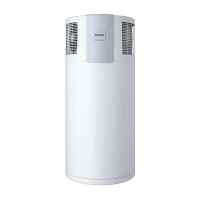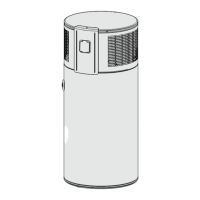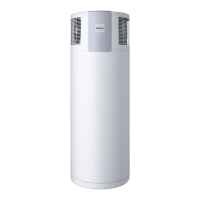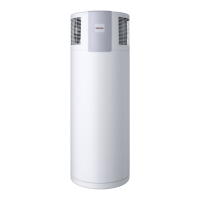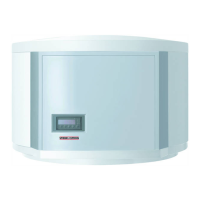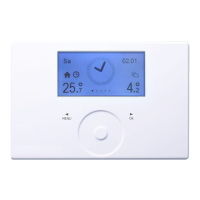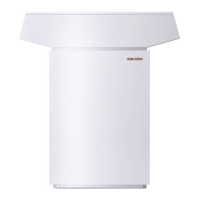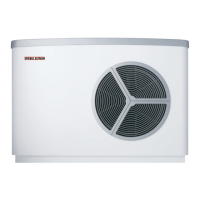OPERATION
Appliance description
6 | WWK222-302 H www.stiebel-eltron.com
In the case of indoor installation, the air inside the installation
room can be cooled by 1°C to 3°C through heat extraction. The
appliance also extracts moisture from the air, which turns into
condensate. The condensate is removed from the appliance via
the condensate drain.
When a hot water draw-off point is opened, the hot DHW is pushed
out of the appliance by the inflow of cold water.
The heat pump drive unit is located in the upper section of the
appliance. The DHW cylinder is located in the lower section of the
appliance. To protect against corrosion, the DHW cylinder is coated
internally with special enamel and is additionally equipped with
an impressed current anode.
3.1 Heat pump operating principle
A closed circuit within the appliance contains refrigerant (see
"Specification/ Data table"). This refrigerant evaporates at low
temperatures. In the evaporator, which extracts heat from the
air drawn in, the refrigerant changes from a liquid into a gas-
eous state. A compressor draws in the gaseous refrigerant and
compresses it. This increase in pressure raises the refrigerant
temperature. That requires electrical energy.
The energy (motor heat) is not lost, but reaches the downstream
condenser together with the compressed refrigerant. There, the
refrigerant transfers heat to the DHW cylinder. An expansion valve
then reduces the still prevalent pressure and the cyclical process
starts again.
3.2 DHW heating
2
D0000050335
1 Cylinder top sensor
2 Integral sensor
The appliance is equipped with two temperature sensors.
- The cylinder top sensor captures the water temperature in
the upper section of the cylinder.
- The integral sensor is a temperature sensor affixed over the
entire cylinder height. The integral sensor determines the
average cylinder temperature.
The appliance control unit uses the average cylinder temperature
captured by the integral sensor. DHW heating is started when
the average cylinder temperature has fallen below the set tem-
perature.
DHW is normally heated by the heat pump of the appliance (see
chapter "Specification/ Data table").
Note
If the appliance has been isolated from the power supply
during operation, the compressor will only restart after
the pressure inside the refrigerant circuit has been equal-
ised. Pressure compensation can take several minutes.
WWK222H|WWK302H: Electric emergency/booster heater
When the temperature in the upper section of the DHW cylinder
drops 10K below the selected set temperature, the appliance
automatically switches on the electric emergency/booster heater.
When the temperature in the upper section of the DHW cylinder
rises 2K above the selected set temperature, the appliance switch-
es off the electric emergency/booster heater.
3.3 Appliance operation outside the application
limits
3.3.1 Ambient temperatures below the application limit
Outside the application limits, the appliance disables the com-
pressor operation. This could lead to reduced DHW convenience.
If the appliance has an electric emergency/booster heater, this
will be enabled if a demand for heating up the water exists and
the lower application limit is underrun.
Low ambient temperatures may result in the formation of hoar
frost on the evaporator depending on the air humidity and water
temperature.
Active defrost feature
The appliance is equipped with active hot gas defrosting, which
allows quick defrosting of the evaporator when needed. During
defrosting, the appliance fan is disabled and the compressor con-
tinues to run. A solenoid valve routes the hot gas directly to the
evaporator. While this is happening, the condenser is disabled by
another solenoid valve.
In contrast to conventional defrosting methods, the appliance
guarantees that defrosting takes place only when needed.
Note
Heat-up times are longer while the evaporator is defrost-
ing.
3.3.2 Ambient temperatures above the application limit
Outside the application limits, the appliance disables the com-
pressor operation. This could lead to reduced DHW convenience.
If the appliance has an electric emergency/booster heater, this
will be enabled if a demand for heating up the water exists and
the lower application limit is underrun.
3.4 Frost protection
The appliance activates the frost protection function if the integral
sensor in the DHW cylinder captures a temperature below 10°C.
The appliance then heats the water by means of the heat pump
and the electric emergency/booster heater. The heat pump and
electric emergency/booster heater switch off when the tempera-
ture captured by the integral sensor reaches 18°C.
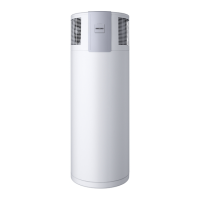
